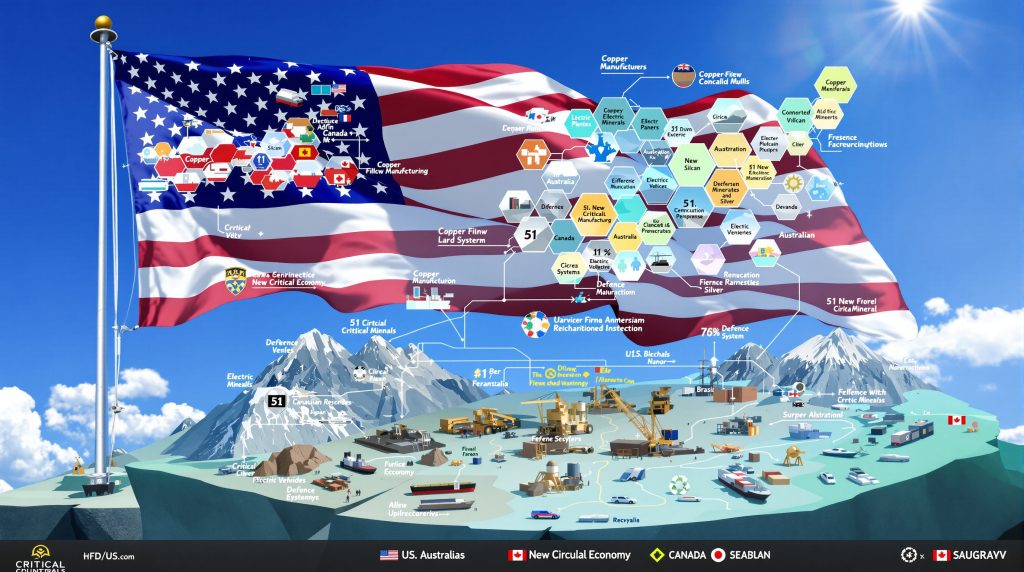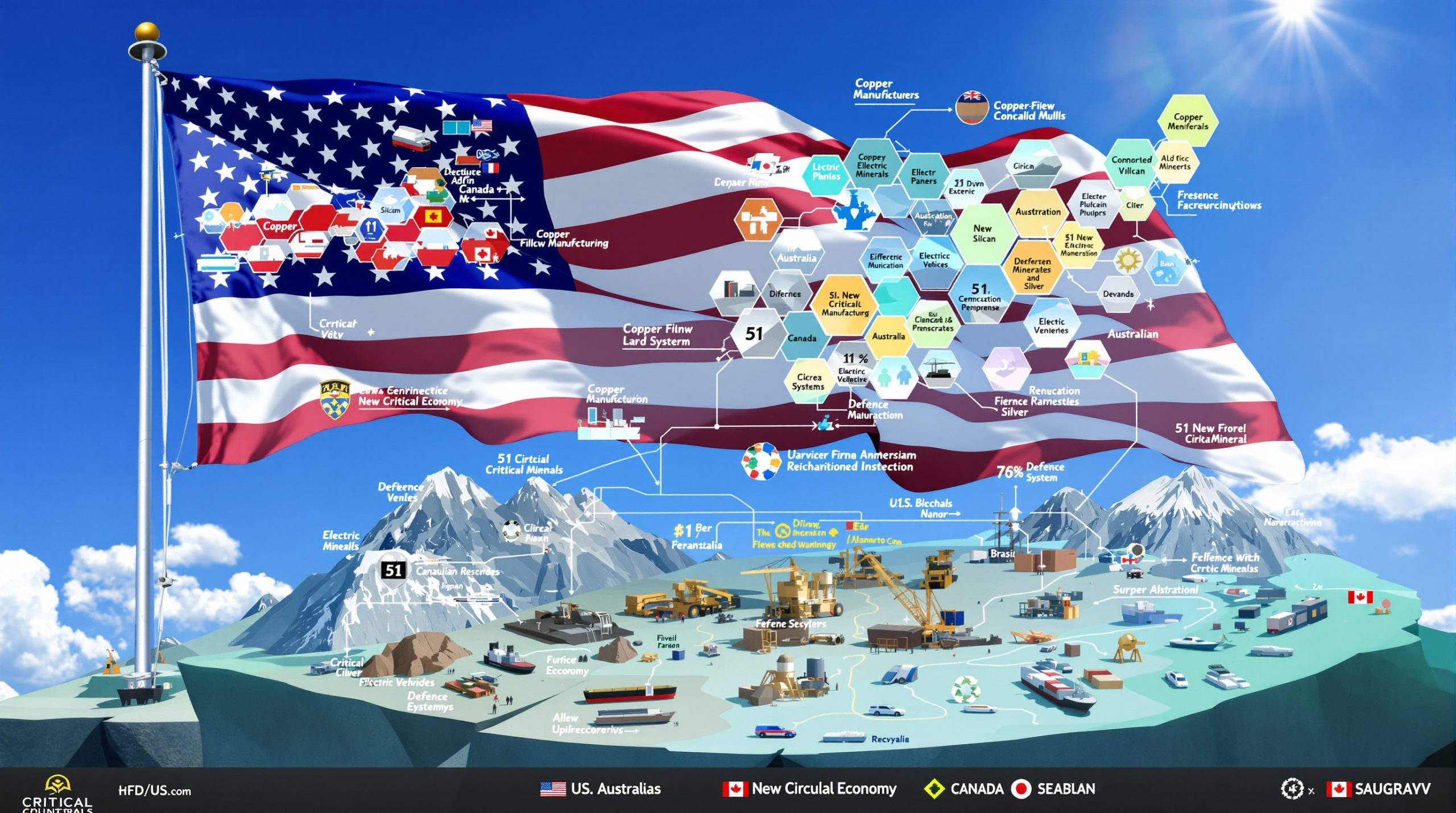How Is the US Expanding Its Critical Minerals List in 2025?
The United States has significantly broadened its critical minerals roster in 2025, adding 51 mined commodities to its official list. This marks the second major update since the list's inception in 2017, reflecting evolving mineral security priorities in a changing global landscape.
The New Critical Minerals Framework
The Department of the Interior's expansion represents a strategic shift from reactive to proactive mineral security planning. The updated methodology assesses minerals through multiple factors:
- Supply chain disruption potential
- Domestic production capacity
- Processing infrastructure availability
- National security implications
- Economic vulnerability
This approach enables more nuanced classification based on specific risk profiles rather than treating all critical minerals with equal urgency.
Key Additions to the 2025 Critical Minerals List
The expanded list incorporates several widely-used industrial metals for the first time:
- Copper: Essential for electrical systems and renewable energy
- Lead: Critical for battery storage and protective applications
- Silver: Vital for electronics and solar panels
- Silicon: Fundamental to semiconductor manufacturing
- Potash: Crucial for agricultural fertilizer production
According to Sarah Ryker, acting director of the US Geological Survey, these selections reflect industries "most affected by supply disruptions" and areas where "domestic investments or international trade relations could mitigate risks."
Why Is the US Revamping Its Critical Minerals Strategy Now?
The timing reflects growing awareness of supply chain vulnerabilities revealed during recent global disruptions and concerns about industrial competitiveness.
Geopolitical Supply Chain Vulnerabilities
Global mineral supply chains have become increasingly concentrated, creating potential chokepoints that threaten economic security:
- Overreliance on single-source suppliers
- Vulnerability to shipping lane disruptions
- Susceptibility to export restrictions
- Limited domestic processing capacity
Supply chain disruptions commonly result from sudden losses of access to overseas minerals due to conflicts, US-China trade tensions, or shipping bottlenecks.
Economic Security Imperatives
The expanded list addresses fundamental economic competitiveness factors:
- Manufacturing revitalization depends on stable material access
- Advanced technology sectors require specialized mineral inputs
- Clean energy transition relies on secure battery metal supplies
- Agricultural productivity depends on fertilizer minerals like potash
By identifying additional minerals as critical, the US acknowledges their essential role in maintaining critical minerals & energy security and technological leadership.
What Government Mechanisms Will Support the Critical Minerals Expansion?
To operationalize the expanded list, the government is deploying multiple policy tools aimed at incentivizing domestic production and processing.
Investment Incentives and Financial Support
Federal agencies are coordinating financial support for critical mineral projects:
- Tax incentives for new mining operations and processing facilities
- Grant programs for innovative extraction technologies
- Loan guarantees for processing infrastructure
- Research funding for alternative materials
These mechanisms aim to overcome capital barriers that have historically made domestic mineral development uncompetitive with foreign sources.
Regulatory and Policy Frameworks
The strategy implements regulatory changes to accelerate domestic mineral development:
- Streamlined permitting for critical mineral projects
- Interagency coordination through dedicated task forces
- Preferential procurement for domestically-sourced materials
- Strategic stockpiling of highest-risk minerals
These policy adjustments aim to reduce regulatory uncertainty while maintaining essential environmental protections. The recent Trump executive order on critical minerals further demonstrates the bipartisan nature of these concerns.
How Does the US Plan to Reduce Reliance on Foreign Mineral Sources?
The 2025 strategy employs a dual approach—strengthening domestic capabilities while diversifying international supply relationships.
Domestic Production Enhancement Strategy
Several pathways are prioritized to increase domestic mineral production:
- Advanced geological surveys using new detection technologies
- Reprocessing of mine tailings and waste containing valuable minerals
- Development of extraction methods for previously uneconomic deposits
- Support for innovative mineral separation technologies
The strategy specifically highlights recovery from mine waste as a promising approach to extract critical minerals while addressing environmental concerns. Furthermore, new mineral exploration programs are receiving unprecedented levels of both public and private funding.
International Partnership Approach
Recognizing that complete mineral self-sufficiency is unrealistic, the strategy focuses on diversifying international supply relationships:
- Developing mineral security alliances with stable partners
- Investing in processing capacity in countries with strong mining sectors
- Creating mineral trade agreements with reciprocal access provisions
- Establishing joint technology initiatives with allied nations
This "ally-shoring" approach aims to reduce concentration risk without attempting complete domestic production of all critical minerals.
What Industries Will Benefit Most From the Expanded Minerals List?
The expanded list will have significant implications across multiple strategic sectors vital to the US economy.
Clean Energy Transition
The renewable energy sector stands to gain substantially:
- Solar manufacturing: Benefits from secure silicon and silver supplies
- Wind energy: Relies on specialized metals for generator components
- Battery production: Depends on multiple critical minerals
- Grid infrastructure: Requires substantial copper and other conductive metals
With renewable deployment accelerating, mineral input security becomes increasingly important to meeting climate goals while creating domestic manufacturing jobs.
Advanced Technology Manufacturing
High-tech sectors will see direct benefits:
- Semiconductor production: Silicon, gallium, and numerous specialty minerals
- Electronics manufacturing: Rare earths, precious metals, and specialty materials
- Defense systems: Specialized alloys and magnetic materials
- Medical devices: Ultra-pure metals for diagnostic equipment
The addition of silicon specifically acknowledges its foundational role in semiconductor manufacturing, which underpins virtually all modern technologies. In addition, the Department of Interior's draft 2025 list of critical minerals emphasizes these technological applications.
How Will the Critical Minerals Strategy Address Environmental Concerns?
The 2025 strategy acknowledges that expanding domestic mineral production must be environmentally responsible to maintain public support.
Sustainable Mining Initiatives
Several components specifically address environmental performance:
- Funding for lower-impact extraction technologies
- Research into biological processes that reduce chemical usage
- Support for energy-efficient processing methods
- Requirements for comprehensive site restoration
These initiatives aim to demonstrate that modern mineral development can proceed with substantially reduced environmental impacts. Many of these approaches represent significant mining industry innovation rather than traditional extraction methods.
Circular Economy Integration
A significant focus involves maximizing recovery and reuse of minerals already in circulation:
- Programs targeting recovery from electronic waste
- Incentives for designing products with material recovery in mind
- Support for specialized recycling technologies
- Research into separation processes for mixed materials
By treating end-of-life products as "urban mines," the strategy reduces both extraction requirements and waste management challenges.
What Challenges Face the US Critical Minerals Expansion?
Despite comprehensive planning, the strategy faces substantial implementation challenges.
Technical and Economic Barriers
Several factors could limit the strategy's success:
- High capital costs for new mines and processing facilities
- Long lead times for permitting and construction
- Technical complexity of processing to required purity levels
- Competition with established international suppliers
These challenges are particularly acute for minerals requiring specialized processing technologies developed primarily overseas in recent decades.
Policy Implementation Hurdles
The strategy also faces policy implementation difficulties:
- Coordinating actions across multiple federal agencies
- Balancing environmental protection with mineral development
- Managing competing land use priorities
- Maintaining consistent support across political transitions
Addressing these challenges requires sustained policy focus and coordination mechanisms that withstand changes in administration.
What Are the Expected Outcomes of the 2025 Critical Minerals Strategy?
The strategy aims to deliver both immediate and long-term benefits to US economic security.
Short-Term Impacts (1-3 Years)
In the near term, likely outcomes include:
- Increased investment in mineral exploration
- Acceleration of permitting for priority projects
- Expansion of processing technology research
- Development of initial strategic stockpiles
These early outcomes set the foundation for longer-term mineral security while providing immediate economic benefits.
Long-Term Strategic Benefits (5-10 Years)
Over the longer term, the strategy aims to reshape US mineral supply chains:
- Reduced import dependencies for key manufacturing inputs
- Domestic processing capabilities for multiple minerals
- Specialized jobs in mining, processing, and manufacturing
- Enhanced resilience against supply disruptions
These outcomes support broader economic goals including manufacturing revitalization and technology leadership.
How Does This Strategy Compare to Other Nations' Approaches?
The US critical minerals strategy exists within a global context where many countries pursue similar objectives through different means.
Global Critical Minerals Landscape
Several major economies have implemented their own strategies:
- The European Union focuses on securing supplies through partnerships
- Japan has developed specialized recycling technologies
- Australia leverages its resource endowment as a trusted supplier
- Canada integrates its mining sector into North American supply chains
These parallel approaches create both competitive challenges and partnership opportunities for US mineral security efforts.
Competitive Positioning Analysis
The US approach has several distinctive characteristics:
- Greater emphasis on private sector investment
- More focus on technological innovation for environmental concerns
- Stronger integration between defense and civilian industrial needs
- Greater reliance on market mechanisms with strategic incentives
These differences reflect underlying economic structures and political priorities that shape how different countries approach mineral security. According to the Energy Department's actions to secure American critical minerals, this reflects a whole-of-government approach to US critical minerals expansion 2025.
Interested in Securing Early Access to Major Mineral Discoveries?
Don't miss out on potential high-return opportunities in the resources sector – Discovery Alert's proprietary Discovery IQ model delivers instant notifications when significant ASX mineral discoveries are announced, giving you a crucial market advantage. Explore historic returns from major discoveries and begin your 30-day free trial today at https://discoveryalert.com.au/discoveries/.




